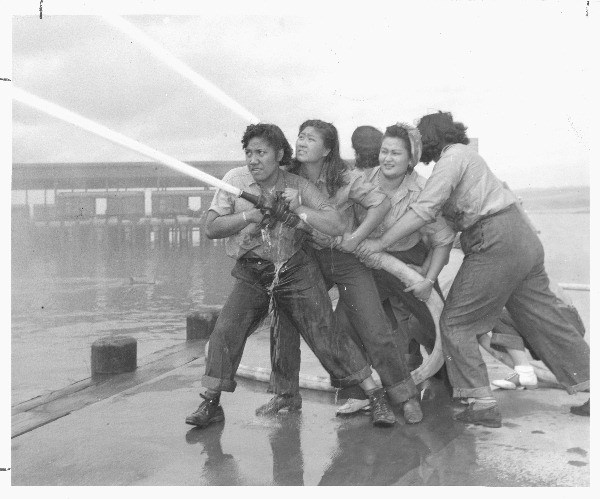Part of a series of articles titled Women's History in the Pacific West - Pacific Islands Collection.
Previous: Princess Luka Ruth Ke'elikōlani
Next: Queen Lili'uokalani
Article

Photo credit: Public Affairs. https://www.navsea.navy.mil/Media/Images/igphoto/2002102638/
Accessed September 2, 2020.
Article Written by Faith Bennett
The striking photo of Katherine Ah Lan Lowe and four other women looking determined as they hold a powerful fire hose steady in the Pearl Harbor Naval Shipyard is familiar to many as an image of female heroism in World War II. It appeared in newspapers, magazines, and history books such as Fit to Fight: Pearl Harbor Naval Shipyard (1908–2008) for decades before Lowe saw it for the first time on the sixtieth anniversary of the attack on Pearl Harbor and corrected the record.1 She had supported the war, transitioning from factory work to shipyard work as many civilian women did, filling positions previously held by men, but only after the infamous 1941 attack, not during it.
Katherine Lowe was born Katherine Ah Lan in Iwilei, Hawai‘i in 1915 to Mary Kailipala Chong and Ching Tong Chong, who raised her in the Church of Jesus Christ of Latter-day Saints.2 In 1931 she married David Kamakaikolia Kauhi with whom she had two sons, David and Joseph. By 1939, the pair had separated and Katherine Ah Lan married her second husband, George Kaina Lowe.3 In 1941 when she received the tragic news that her son Joseph died as a result of an accident at the home of his babysitter, Lowe was working as a trimmer at the Dole Pineapple Cannery.4 The Dole company, founded by a descendant of Anglo Christian missionaries to Hawai‘i, was one of the powerful US companies whose commercial and political interests dominated the islands.
On December 7, 1941 Lowe and her family were preparing to go to church when her then six-year-old son, David, told her “we’re at war.” Since they were already dressed, she said they would go to church anyway. “We didn’t know it was an attack,” she recalled.5 That evening, however, she remembered covering the windows of the house in fear that Japanese bombers would see their lights and target them. After the attack on Pearl Harbor, Lowe and her best friend Elizabeth Moku, as well as several other employees from the Dole Pineapple Cannery, applied for civilian jobs at the Pearl Harbor Naval Shipyard, the very site of the deadly attack. The women worked in the storage area of the shipyard where they transported materials and learned how to handle fire hoses because of the area’s vulnerability to fire. The women carried oil drums and heavy equipment: “we were rugged,” Lowe remembered.6
In 1944, Lowe and her husband George moved to Okinawa, Japan, where he served as marine superintendent for twenty-two years before moving the family back to Honolulu in 1968 upon his retirement.7 Katherine Lowe went on to have a total of 8 children and lived to see 52 grandchildren, 137 great-grandchildren, 115 great-great-grandchildren, and even 20 great-great-great-grandchildren. She was an avid bowler and hula dancer into her nineties.8 At the age of ninety-six she proudly told the NBC reporters who visited her home that she was still bowling a 145 average, and she offered to dance a hula for her guests. In August 2015, Lowe celebrated her one hundredth birthday at a large party surrounded by friends and family. In what her friend Siana Burgess described as an “Aloha moment,” Lowe joined in on the hula meant to honor her at the party.9 She died a few months later, in November.
1 - Susana Polo, “Found: Identity of the Female Fire Fighters at Pearl Harbor,” The Mary Sue, December 13, 2011, Accessed August 14, 2020.
https://www.themarysue.com/found-identity-of-the-female-fire-fighters-a-pearl-harbor/; Burl Burlingame, “Tip Top Ship Shop,” The Honolulu Star Bulletin, June 22, 2008, Accessed August 14, 2020.
http://archives.starbulletin.com/2008/06/22/features/story01.html. The Polo article references additional television reporting on the story.
2 - Though Lowe’s mother’s name is consistently cited as Mary Kailipala Chong, Lowe’s father’s name varies, possibly due to variation in the way census takers and newspaper writers transliterated it. Ching Chong is the most commonly used name to refer to Lowe’s father. “Ching, Mary Kailipala,” The Honolulu Advertiser, August 28, 1946, sec. Funeral Notices, p. 21; “Vital Statistics,” The Honolulu Advertiser, August 14, 1915, p. 6.
US Census Bureau, Year: 1930; Census Place: Honolulu, Honolulu, Hawaii Territory, p. 20A, Enumeration District 0076; FHL microfilm: 2342369. Ancestry.com; 1930 United States Federal Census [database on-line]. Provo, UT, USA: Ancestry.com Operations Inc., 2002.
3 - “Marriage Licenses,” The Honolulu Advertiser, August 25, 1939, p. 13; US Census Bureau, Year: 1940; Census Place: Honolulu, Honolulu, Hawaii, roll m-t0627-04587, p. 7A, enumeration district 2-161. Ancestry.com. 1940 United States Federal Census [database on-line]. Provo, UT, USA: Ancestry.com Operations, Inc., 2012.
4 - “Kauhi, Joseph Kamakaikolea,” The Honolulu Advertiser, December 10, 1941, sec. Funeral Notices, 10. “Pearl Harbor Surprise: Photo of Female Firefighters Wasn't from Dec. 7,” NBCNews.com (NBCUniversal News Group, December 12, 2011), http://investigations.nbcnews.com/_news/2011/12/12/9377669-pearl-harbor-surprise-photo-of-female-firefighters-wasnt-from-dec-7.
5 - Brooks Baehr, “Laie Woman Corrects Story behind Famous Pearl Harbor Picture,” Hawaii News Now, December 29, 2011, Accessed August 14, 2020.
https://www.hawaiinewsnow.com/story/16408792/laie-woman-corrects-story-behind-famous-pearl-harbor-picture/.
6 - “Pearl Harbor Surprise.”
7 - “Lowe, George Kaina,” The Honolulu Star Bulletin, July 22, 1970, sec. Obituaries, p. 52.
8 - Justice Vanatta, “A Legacy of Excellence,” Naval Sea Systems Command, March 18, 2019, Accessed August 14, 2020,
https://www.navsea.navy.mil/Media/News/SavedNewsModule/Article/1788004/a-legacy-of-excellence/; “Pearl Harbor Surprise.”
9 - Vanatta, “A Legacy of Excellence”; Carla Herreria Russo, “100-Year-Old Woman Does Spontaneous Hula At Her Birthday Luau,” Huffington Post, August 25, 2015, Accessed August 22, 2020,
https://www.huffpost.com/entry/100-year-old-birthday-girl-hula_n_55dbaa5ee4b04ae49704394a.
Part of a series of articles titled Women's History in the Pacific West - Pacific Islands Collection.
Previous: Princess Luka Ruth Ke'elikōlani
Next: Queen Lili'uokalani
Last updated: April 12, 2022